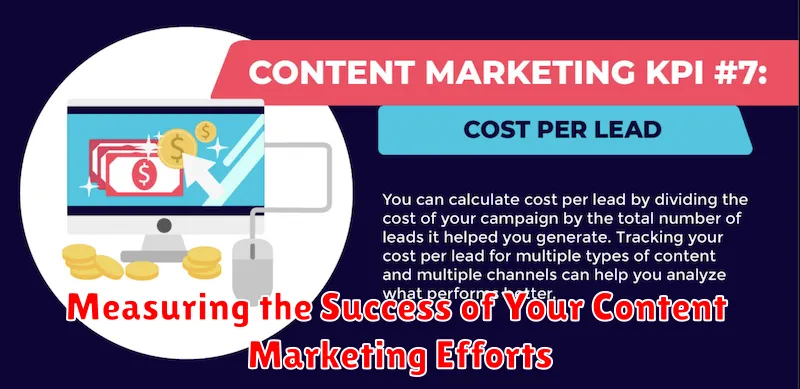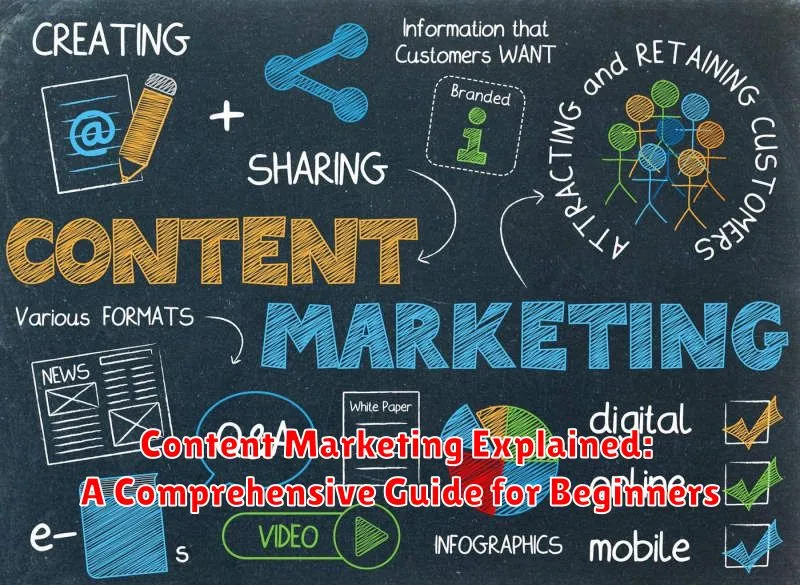In today’s digital landscape, content marketing plays a pivotal role in connecting businesses with their target audiences. This comprehensive guide aims to demystify content marketing for beginners, providing a foundational understanding of its core principles, strategies, and benefits. Whether you are an entrepreneur, a small business owner, or a marketing enthusiast, mastering the art of content marketing is essential for building brand awareness, generating leads, and ultimately driving sales. This guide will equip you with the knowledge and tools necessary to develop a successful content marketing strategy.
Content marketing is more than just creating and distributing content; it’s a strategic approach that focuses on providing valuable and relevant information to attract and engage a clearly defined audience. Through consistent delivery of high-quality content, you can build trust, establish credibility, and nurture long-term relationships with your customers. This guide will delve into the various aspects of content marketing, from planning and creation to distribution and analysis, enabling you to leverage its power to achieve your business objectives. You’ll learn how content marketing can effectively differentiate your brand, position you as an industry leader, and drive measurable results.
Defining Content Marketing and Its Purpose
Content marketing is a strategic marketing approach focused on creating and distributing valuable, relevant, and consistent content to attract and retain a clearly defined target audience — and, ultimately, to drive profitable customer action.
It’s not about directly promoting a product or service, but rather providing information that educates and engages the audience. This fosters trust and establishes your brand as a credible source in the industry.
Key Purposes of Content Marketing:
- Brand Awareness: Establish your brand presence and increase visibility among potential customers.
- Lead Generation: Capture contact information from interested prospects.
- Customer Acquisition: Convert leads into paying customers.
- Customer Retention: Build loyalty and encourage repeat business.
- Thought Leadership: Position your brand as an authority in your field.
Understanding the Benefits of Content Marketing for Businesses
Content marketing offers numerous advantages for businesses seeking to grow and connect with their audience. It’s a powerful tool that goes beyond traditional advertising, focusing on building relationships and providing value.
One key benefit is increased brand awareness. By consistently delivering valuable content, businesses can establish themselves as thought leaders in their industry and build trust with potential customers. This consistent presence keeps the brand top-of-mind.
Improved search engine optimization (SEO) is another crucial advantage. High-quality content, optimized with relevant keywords, can significantly boost a website’s search engine rankings, driving organic traffic and increasing visibility.
Content marketing also contributes to lead generation. By offering valuable resources like ebooks or webinars in exchange for contact information, businesses can capture leads and nurture them through the sales funnel.
Finally, content marketing helps drive conversions. By providing informative and persuasive content that addresses customer pain points and demonstrates product/service value, businesses can encourage purchase decisions and foster customer loyalty.
Identifying Your Target Audience and Their Content Needs
Before creating any content, it’s crucial to identify your target audience. Understanding your audience is the foundation of effective content marketing. Who are you trying to reach? What are their demographics, interests, and pain points?
Defining your target audience involves creating buyer personas. These semi-fictional representations of your ideal customer help you visualize and understand their needs, motivations, and online behavior. Consider factors like age, location, occupation, income level, and online platforms they frequent.
Once you understand who your target audience is, you need to determine their content needs. What information are they seeking? What problems are they trying to solve? What kind of content will resonate with them? Researching keywords and analyzing competitor content can provide valuable insights into audience interests.
By clearly defining your target audience and understanding their content needs, you can create content that is relevant, engaging, and ultimately, effective in achieving your marketing goals.
Developing a Content Strategy and Creating a Content Calendar
A well-defined content strategy is crucial for successful content marketing. This strategy acts as a roadmap, guiding your content creation efforts towards achieving specific business goals.
Start by clearly defining your target audience and their content needs. Then, establish your content marketing objectives. These objectives could include increasing brand awareness, driving website traffic, generating leads, or boosting sales.
Once you have a clear strategy, developing a content calendar is essential for organized content creation and distribution. A content calendar is a schedule that outlines what content will be published, when, and on which platforms. It helps maintain consistency and ensures a steady flow of valuable content.
Your content calendar should include key details like content topics, formats, publishing dates, target keywords, and assigned authors or teams. Regularly review and update your content calendar to stay on track and adapt to changes in your business needs or industry trends.
Creating High-Quality, Engaging Content in Various Formats

Content format is crucial for reaching and resonating with your target audience. Diversifying content keeps your audience engaged and caters to different learning styles.
Written Content
This cornerstone of content marketing includes blog posts, articles, eBooks, and case studies. Focus on providing valuable information, clear language, and strong calls to action.
Visual Content
Infographics, images, and memes can quickly communicate complex information and enhance engagement. Visuals should be high-quality and relevant to the accompanying text.
Video Content
Explainer videos, product demonstrations, and interviews provide dynamic and engaging content. Keep videos concise and focused on delivering key messages effectively.
Audio Content
Podcasts and audiobooks offer convenient content consumption for busy audiences. High-quality audio and engaging discussion are essential for success.
Optimizing Content for Search Engines and User Experience
Optimizing content involves balancing search engine optimization (SEO) with a positive user experience (UX). SEO focuses on making your content visible to search engines, while UX ensures your content is engaging and easy to consume for your audience.
Key SEO elements include incorporating relevant keywords throughout your content, using descriptive meta descriptions, and optimizing title tags. Ensure your website has a clear site architecture and fast loading speeds. These technical aspects significantly influence search engine rankings.
For UX, prioritize readability. Use headings, subheadings, bullet points, and short paragraphs to break up large blocks of text. A clear and concise writing style improves comprehension. Mobile optimization is crucial; ensure your content adapts seamlessly to different screen sizes.
Promoting and Distributing Your Content Across Different Channels
Creating high-quality content is only the first step. Effective promotion and distribution are crucial for reaching your target audience. Consider these channels:
Social Media Marketing
Share your content across relevant social media platforms. Tailor your message to each platform’s audience and utilize relevant hashtags. Engage with your followers and participate in relevant discussions.
Email Marketing
Build an email list and deliver your content directly to subscribers’ inboxes. Segment your list to personalize content and improve engagement.
Paid Advertising
Utilize platforms like Google Ads and social media advertising to boost your content’s reach. Target specific demographics and interests to maximize your return on investment.
Influencer Marketing
Partner with influencers in your niche to expand your content’s visibility to a wider audience. Ensure the influencer’s audience aligns with your target market.
Measuring the Success of Your Content Marketing Efforts

Measuring the success of your content marketing initiatives is crucial for understanding what works and what doesn’t. This allows you to refine your strategy and maximize your return on investment.
Key Performance Indicators (KPIs) provide quantifiable metrics to track progress. Some important KPIs to consider include:
- Website Traffic: Monitor increases in organic traffic, referral traffic, and direct traffic to your website.
- Engagement Metrics: Track likes, shares, comments, and time spent on page to gauge audience interaction.
- Lead Generation: Measure the number of leads generated through content, such as newsletter sign-ups or contact form submissions.
- Conversions: Analyze how many leads convert into paying customers, demonstrating the effectiveness of your content in driving sales.
Utilizing analytics tools such as Google Analytics can provide valuable data and insights into these KPIs. Regular monitoring and analysis will help you identify successful content pieces and areas for improvement.
Staying Updated with the Latest Content Marketing Trends
The digital landscape is constantly evolving, making it crucial to stay informed about the latest content marketing trends. Failing to adapt can lead to stagnation and missed opportunities. Continuous learning is key to remaining competitive and effective.
Several avenues exist for staying current. Industry blogs and publications offer valuable insights and analysis. Subscribing to newsletters from reputable sources can deliver updates directly to your inbox. Attending webinars and conferences provides opportunities to learn from experts and network with peers.
Following influential thought leaders on social media platforms can also keep you abreast of emerging trends. Finally, experimentation is essential. Don’t be afraid to try new tactics and analyze the results to see what resonates with your target audience.

